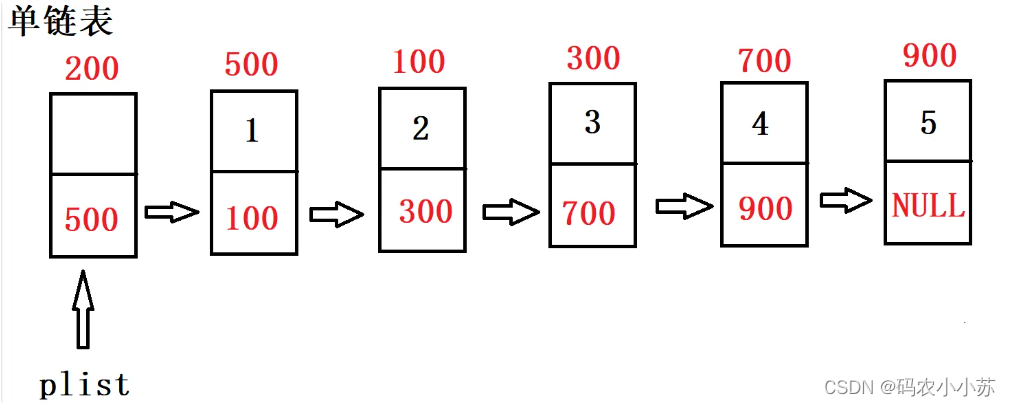一.单链表的设计
1.单链表的结构定义:
typedef struct Node{
int data;//数据域
struct Node* next;//后继指针
}Node,*List;
3.注意,单链表的最后一个节点的next域为NULL;
4.为什么要有一个头节点?(简单方便,不用传二级指针);
二.单链表的实现
//初始化
void InitList(List plist)
{
assert(plist != NULL);
if (plist == NULL)
return;
//plist->data;//头节点的数据域不使用
plist->next = NULL;
}
//考试重点
//头插
bool Insert_head(List plist, int val)
{
assert(plist != NULL);
if (plist == NULL)
return false;
//动态申请一个节点
Node* p = (Node *)malloc(sizeof(Node));
assert(p != NULL);
//将数据val放入到新节点
p->data = val;
//插入新节点
p->next = plist->next;
plist->next = p;
return true;
}
//考试重点
//尾插
bool Insert_tail(List plist, int val)
{
assert(plist != NULL);
if (plist == NULL)
return false;
//申请节点
Node* p = (Node*)malloc(sizeof(Node));
assert(p != NULL);
//将数据val放入到新节点
p->data = val;
//找尾巴
Node* q;
for(q=plist;q->next!=NULL;q=q->next)
{
;
}
//插入新节点
p->next = q->next;//p->next=NULL;
q->next = p;
return true;
}
//插入数据,在plist链表的pos位置插入val;
bool Insert(List plist, int pos, int val)
{
assert(plist != NULL);
if (plist == NULL)
return false;
if (pos<0 || pos>GetLength(plist))
{
return false;
}
Node* p = (Node*)malloc(sizeof(Node));
assert(p != NULL);
p->data = val;
//找到位置
Node* q;
int i;
for (q = plist, i = 0; i < pos; i++, q = q->next)
{
;
}
// 插入
p->next = q->next;
q->next = p;
return true;
}
//判空
bool IsEmpty(List plist)
{
assert(plist != NULL);
if (plist == NULL)
return false;
return plist->next == NULL;
}
//获取数据节点的个数
int GetLength(List plist)
{
assert(plist != NULL);
if (plist == NULL)
return 0;
int count = 0;
for (Node* p = plist->next; p!= NULL; p = p->next)
{
count++;
}
return count;
}
//在plist中查找第一个key值,找到返回节点地址,没有找到返回NULL;
Node* Search(List plist, int key)
{
assert(plist != NULL);
if (plist == NULL)
return NULL;
for (Node* p = plist->next; p != NULL; p = p -> next)
{
if (p->data == key)
{
return p;
}
}
return NULL;
}
//删除pos位置的值
bool DelPos(List plist, int pos)
{
assert(plist != NULL);
if (plist == NULL)
return false;
if (pos < 0 || pos >= GetLength(plist))
{
return false;
}
Node* p;
int i;
for (p = plist, i = 0; i < pos; i++, p = p->next)
{
;
}
//删除p后面的节点
Node* q = p->next;
p->next = q->next;
free(q);
return true;
}
//考试重点
//删除第一个val的值
bool DelVal(List plist, int val)
{
Node* p = GetPrio(plist, val);
if (p == NULL)
return false;
Node* q = p->next;
//删除q
p->next = q->next;//p->next=p->next->next;
//释放q
free(q);
return true;
}
//返回key的前驱地址,如果不存在返回NULL;
Node* GetPrio(List plist, int key)
{
for (Node* p = plist; p->next != NULL; p = p->next)
{
if (p->next->data == key)
return p;
}
return NULL;
}
//返回key的后继地址,如果不存在返回NULL;
Node* GetNext(List plist, int key)
{
assert(plist != NULL);
if (plist == NULL)
return NULL;
Node* p = Search(plist, key);
if (p == NULL)
return NULL;
return p->next;
}
//输出
void Show(List plist)
{
//注意,头节点不能访问data
for (Node* p = plist->next; p != NULL; p = p->next)
{
printf("%d ", p->data);
}
printf("\n");
}
//清空数据
void Clear(List plist)
{
Destroy(plist);
}
void Destroy(List plist)
{
//总是删除第一个数据节点
Node* p;
while (plist->next != NULL)
{
p = plist->next;
plist->next = p->next;
free(p);
//error
//plist->next = plist->next->next;
//free(plist->next);
}
}三.单链表的总结
头插,头删 时间复杂度是O(1)
尾插,尾删 时间复杂度是O(n)
本篇完!